Sevoflurane
Piramal Critical Care Inc
Piramal Critical Care Inc
Sevoflurane - Generic
FULL PRESCRIBING INFORMATION: CONTENTS*
- SEVOFLURANE DESCRIPTION
- CLINICAL PHARMACOLOGY
- INDICATIONS & USAGE
- SEVOFLURANE CONTRAINDICATIONS
- WARNINGS
- PRECAUTIONS
- SEVOFLURANE ADVERSE REACTIONS
- OVERDOSAGE
- DOSAGE & ADMINISTRATION
- HOW SUPPLIED
- Manufactured By
- Bottle Label - 250 ml
- Bottle Label - 100 ml
FULL PRESCRIBING INFORMATION
SEVOFLURANE DESCRIPTION
437

Sevoflurane, Physical Constants are:
Molecular weight 200.05
Boiling point at 760 mm Hg 58.6°C
Specific gravity 20°C 1.520 to 1.525
Vapor pressure in mm Hg 157 mmHg at 20°C
197 mmHg at 25°C
Distribution Partition Coefficients at 37°C:
Water/gas 0.36
Blood/gas 0.63 to 0.69
Olive Oil/gas 47 to 54
Mean Component/Gas Partition Coefficients at 25°C for Polymers Used Commonly in Medical Applications:
Conductive rubber 14.0
Polyvinylchloride 17.4
Polyethylene 1.3
2®2®
4265662
Figure 1: Fresh Gas Flow Rate versus Compound A Levels in a Circle Absorber System
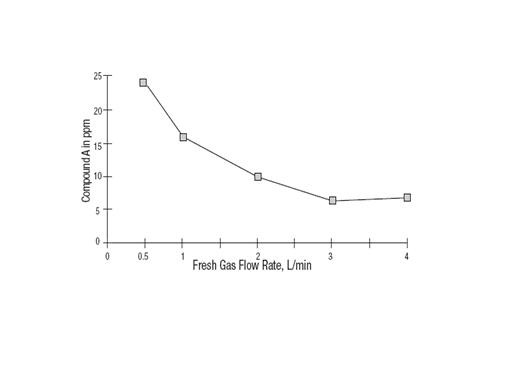
22in vitro2
Figure 2: Carbon Dioxide Flow Versus Compound A and Maximum Temperature
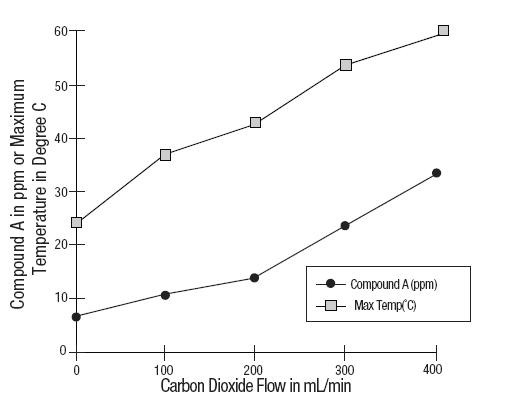
Compound A
2®®
Figure 2a: ppm . hr versus MAC . hr at Flow Rate of 1 L/min
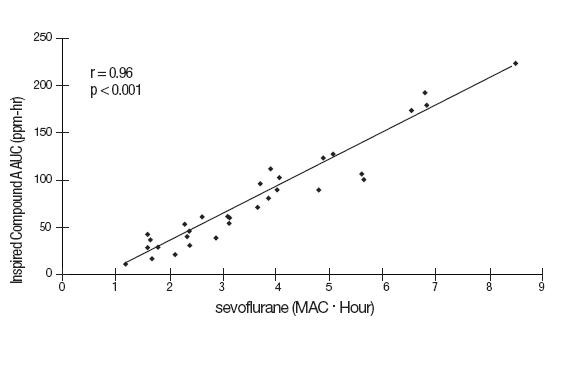
50
An experiment was performed comparing sevoflurane
At a fresh gas flow rate of 1 L/min, mean maximum concentrations of Compound A in the anesthesia circuit in clinical settings are approximately 20 ppm (0.002%) with soda lime and 30 ppm (0.003%) with Baralyme® in adult patients; mean maximum concentrations in pediatric patients with soda lime are about half those found in adults. The highest concentration observed in a single patient with Baralyme® was 61 ppm (0.0061%) and 32 ppm (0.0032%) with soda lime. The level of Compound A at which toxicity occurs in humans is not known.
The second pathway for degradation of sevoflurane occurs primarily in the presence of desiccated CO2 absorbents and leads to the dissociation of sevoflurane into hexafluoroisopropanol (HFIP) and formaldehyde. HFIP is inactive, non-genotoxic, rapidly glucuronidated and cleared by the liver. Formaldehyde is present during normal metabolic processes. Upon exposure to a highly desiccated absorbent, formaldehyde can further degrade into methanol and formate. Formate can contribute to the formation of carbon monoxide in the presence of high temperature that can be associated with desiccated Baralyme®. Methanol can react with Compound A to form the methoxy addition product Compound B. Compound B can undergo further HF elimination to form Compounds C, D, and E.
222®
CLINICAL PHARMACOLOGY
DOSAGE AND ADMINISTRATION
Pharmacokinetics
Uptake and Distribution
Solubility
Because of the low solubility of sevoflurane in blood (blood/gas partition coefficient @ 37°C = 0.63 to 0.69), a minimal amount of sevoflurane is required to be dissolved in the blood before the alveolar partial pressure is in equilibrium with the arterial partial pressure. Therefore there is a rapid rate of increase in the alveolar (end-tidal) concentration (FA) toward the inspired concentration (FI) during induction.
Induction of Anesthesia
22AI
FA/FI data from this study were compared with FA/FI data of other halogenated anesthetic agents from another study. When all data were normalized to isoflurane, the uptake and distribution of sevoflurane was shown to be faster than isoflurane and halothane, but slower than desflurane. The results are depicted in Figure 3.
Recovery from Anesthesia
AO
Figure 3: Ratio of Concentration of Anesthetic in Alveolar Gas to Inspired Gas

Figure 4: Concentration of Anesthetic in Alveolar Gas Following Termination of Anesthesia
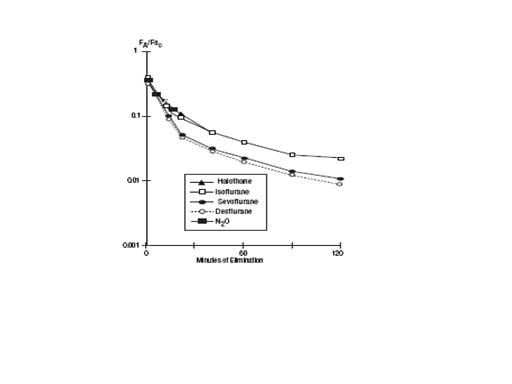
Protein Binding
The effects of sevoflurane on the displacement of drugs from serum and tissue proteins have not been investigated. Other fluorinated volatile anesthetics have been shown to displace drugs from serum and tissue proteins in vitro. The clinical significance of this is unknown. Clinical studies have shown no untoward effects when sevoflurane is administered to patients taking drugs that are highly bound and have a small volume of distribution (e.g., phenytoin).
Metabolism
Sevoflurane is metabolized by cytochrome P450 2E1, to hexafluoroisopropanol (HFIP) with release of inorganic fluoride and CO2. Once formed HFIP is rapidly conjugated with glucuronic acid and eliminated as a urinary metabolite. No other metabolic pathways for sevoflurane have been identified. In vivo metabolism studies suggest that approximately 5% of the sevoflurane dose may be metabolized.
Cytochrome P450 2E1 is the principal isoform identified for sevoflurane metabolism and this may be induced by chronic exposure to isoniazid and ethanol. This is similar to the metabolism of isoflurane and enflurane and is distinct from that of methoxyflurane, which is metabolized via a variety of cytochrome P450 isoforms. The metabolism of sevoflurane is not inducible by barbiturates. As shown in Figure 5, inorganic fluoride concentrations peak within 2 hours of the end of sevoflurane anesthesia and return to baseline concentrations within 48 hours post-anesthesia in the majority of cases (67%). The rapid and extensive pulmonary elimination of sevoflurane minimizes the amount of anesthetic available for metabolism.
Figure 5: Serum Inorganic Fluoride Concentrations for sevoflurane and Other Volatile Anesthetics
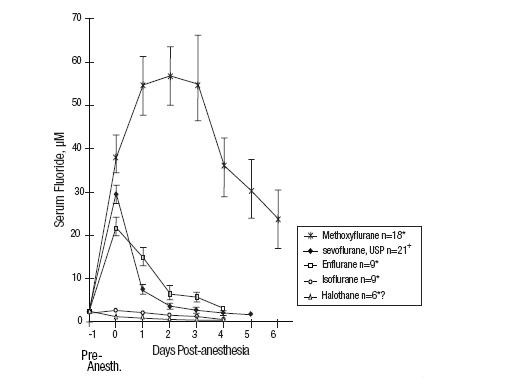
Legend: Pre-Anesth. = Pre-anesthesia
Elimination
Up to 3.5% of the sevoflurane dose appears in the urine as inorganic fluoride. Studies on fluoride indicate that up to 50% of fluoride clearance is nonrenal (via fluoride being taken up into bone).
Pharmacokinetics of Fluoride Ion
It has been reported that following administration of methoxyflurane, serum inorganic fluoride concentrations >50 μM were correlated with the development of vasopressin-resistant, polyuric, renal failure. In clinical trials with sevoflurane there were no reports of toxicity associated with elevated fluoride ion levels.
Figure 6: Fluoride Ion Concentrations Following Administration of Sevoflurane (mean MAC = 1.27, mean duration = 2.06 hr) Mean Fluoride Ion Concentrations (n = 48)
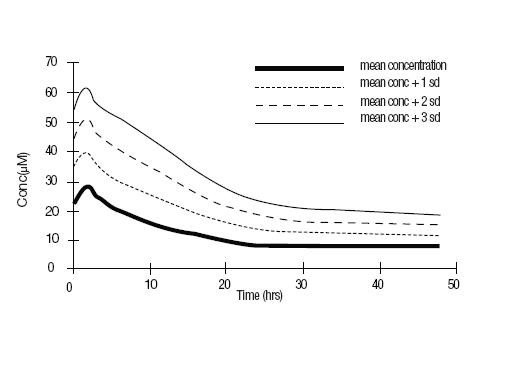
luoride Concentrations After Repeat Exposure and in Special Populations
Fluoride concentrations have been measured after single, extended, and repeat exposure to sevoflurane in normal surgical and special patient populations, and pharmacokinetic parameters were determined.
MAX
Table 1: Fluoride Ion Estimates in Special Populations Following Administration of Sevoflurane
Table 1: Fluoride Ion Estimates in Special Populations
Following Administration of Sevoflurane
n Age(yr) Duration(hr) Dose(MAC.hr) Cmax(µM)
PEDIATRIC PATIENTS
Anesthetic
Sevoflurane-O2 76 0-11 0.8 1.1 12.6
Sevoflurane- O2 40 1-11 2.2 3.0 16.0
Sevoflurane/N2O 25 5-13 1.9 2.4 21.3
Sevoflurane/ N2O 42 0-18 2.4 2.2 8.4
Sevoflurane/ N2O 40 1-11 2.0 2.6 15.5
ELDERLY 33 65-93 2.6 1.4 25.6
RENAL 21 29-83 2.5 1.0 26.1
HEPATIC 8 42-79 3.6 2.2 30.6
OBESE 35 24-73 3.0 1.7 38.0
Pharmacodynamics
·Time to removal of the endotracheal tube (extubation time)
·Time required for the patient to open his/her eyes on verbal command (emergence time)
·Time to respond to simple command (e.g., squeeze my hand) or demonstrates purposeful movement (response to command time, orientation time)
2.Recovery of cognitive function and motor coordination was evaluated based on:
·Psychomotor performance tests (Digit Symbol Substitution Test [DSST], Treiger Dot Test)
·The results of subjective (Visual Analog Scale [VAS]) and objective (objective pain-discomfort scale [OPDS]) measurements
·Time to administration of the first post-anesthesia analgesic medication
·Assessments of post-anesthesia patient status
3.Other recovery times were:
·Time to achieve an Aldrete Score of ≥ 8
·Time required for the patient to be eligible for discharge from the recovery area, per standard criteria at site
·Time when the patient was eligible for discharge from the hospital
·Time when the patient was able to sit up or stand without dizziness
Some of these variables are summarized as follows:
Table 2: Induction and Recovery Variables for Evaluable Pediatric Patients in Two Comparative Studies: Sevoflurane versus Halothane
Time to End-Point (min) Sevoflurane, USP Mean ± SEM Halothane Mean ± SEM
Induction 2.0 ± 0.2 (n=294) 2.7 ± 0.2 (n=252)
Emergence 11.3 ± 0.7 (n=293) 15.8 ± 0.8 (n=252)
Response to command 13.7 ± 1.0 (n=271) 19.3 ± 1.1 (n=230)
First analgesia 52.2 ± 8.5 (n=216) 67.6 ± 10.6 (n=150)
Eligible for recovery discharge 76.5 ± 2.0 (n=292) 81.1 ± 1.9 (n=246)
Table 3: Recovery Variable for Evaluable Adult Patients in Two Comparative Studies: Sevoflurane versus Isoflurane
Time to Parameter (min) Sevoflurane, USP Mean ± SEM Isoflurane Mean ± SEM
Emergence 7.7 ± 0.3 (n=395) 9.1 ± 0.3 (n=348)
Response to command 8.1 ± 0.3 (n=395) 9.7 ± 0.3 (n=345)
First analgesia 42.7 ± 3.0 (n=269) 52.9 ± 4.2 (n=228)
Eligible for recovery discharge 87.6 ± 5.3 (n=244) 79.1 ± 5.2 (n=252)
Table 4: Meta-Analyses for Induction and Emergence Variables for Evaluable Adult Patients in Comparative Studies: Sevoflurane versus Propofol
Parameter No. of Studies Sevoflurane, USP Propofol
Mean ± SEM Mean ± SEM
Mean maintenance 3 1.0 MAC.hr.±0.8 7.2 mg/kg/hr±2.6
anesthesia exposure (n=259) (n=258)
Time to induction: (min) 1 3.1±0.18* 2.2±0.18**
(n=93) (n=93)
Time to emergence: (min) 3 8.6±0.57 11.0±0.57
(n=255) (n=260)
Time to respond to command 3 9.9±0.60 12.1±0.60
(min) (n=257) (n=260)
Time to first analgesia: (min) 3 43.8±3.79 57.9±3.68
(n=177) (n=179)
Time to eligibility for recovery 3 116.0±4.15 115.6±3.98
discharge: (min) (n=257) (n=261)
**Propofol induction of all propofol groups = mean of 170.2mg ± 60.6 SD (n=245)
n = number of patients with recording of events.
Cardiovascular Effects
222222
Figure 7: Heart Rate
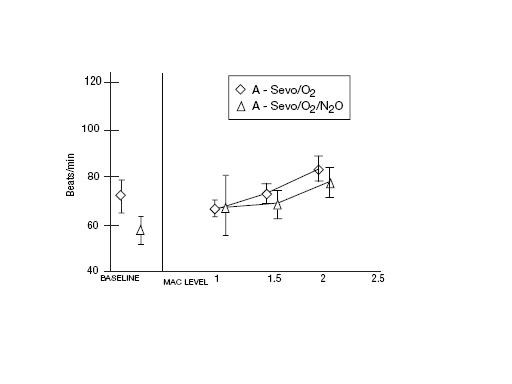
Figure 8: Mean Arterial Pressure
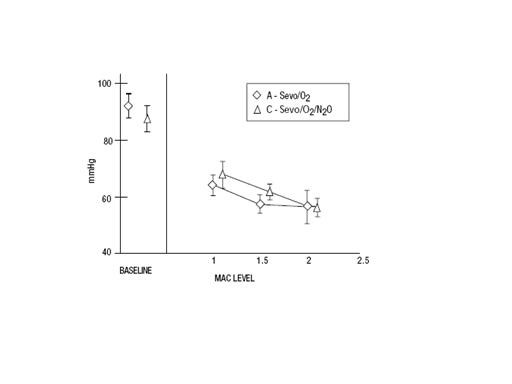
Figure 9: Systemic Vascular Resistance
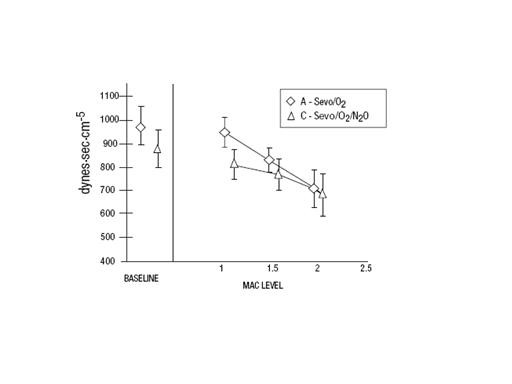
Figure 10: Cardiac Index
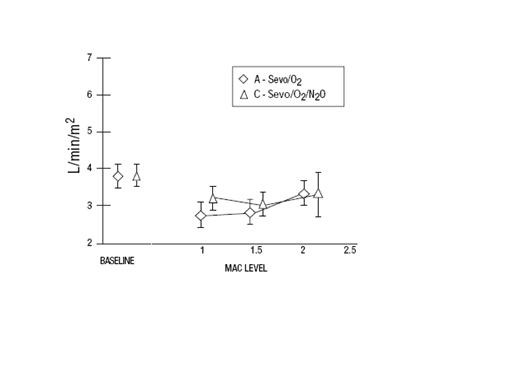
Clinical Trials
Sevoflurane was administered to a total of 3185 patients prior to sevoflurane NDA submission. The types of patients are summarized as follows:
Table 5: Patients Receiving Sevoflurane, in Clinical Trials
Types of Patients Number Studied
ADULT 2223
Cesarean Delivery 29
Cardiovascular and patients at risk of myocardial ischemia 246
Neurosurgical 22
Hepatic impairment 8
Renal impairment 35
PEDIATRIC 962
Clinical experience with these patients is described below.
Adult Anesthesia
Mask Induction
Sevoflurane has a non-pungent odor and does not cause respiratory irritability.
Sevoflurane is suitable for mask induction in adults. In 196 patients, mask induction was smooth and rapid, with complications occurring with the following frequencies: cough, 6%; breath holding, 6%; agitation, 6%; laryngospasm, 5%.
Ambulatory Surgery
Table 6: Recovery Parameters in Two Outpatient Surgery Studies: Least Squares Mean ± SEM
Sevoflurane /N2O Isoflurane/ N2O Sevoflurane / N2O Propofol/ N2O
Mean Maintenance 0.64±0.03 0.66±0.03 0.8±0.5 7.3±2.3
Anesthesia MAC.hr. MAC.hr. MAC.hr. mg/kg/hr.
Exposure ± SD (n=245) (n=249) (n=166) (n=166)
Time to 8.2±0.4 9.3±0.3 8.3±0.7 10.4±0.7
Emergence (min) (n=246) (n=251) (n=137) (n=142)
Time to respond 8.5±0.4 9.8±0.4 9.1±0.7 11.5±0.7
To Commands (min) (n=246) (n=248) (n=139) (n=143)
Time to First 45.9±4.7 59.1±6.0 46.1±5.4 60.0±4.7
Analgesia (min) (n=160) (n=252) (n=83) (n=88)
Time to Eligibility 87.6±5.3 79.1±5.2 103.1±3.8 105.1±3.7
for Discharge from (n=244) (n=252) (n=139) (n=143)
Recovery Area (min)
Inpatient Surgery
Table 7: Recover Parameters in Two Inpatient Surgery Studies: Least Squares Mean ± SEM
Sevoflurane /N2O Isoflurane/N2O Sevoflurane /N2O Propofol/N2O
Mean Maintenance 1.27 MAC.hr. 1.58 MAC.hr. 1.43 MAC.hr. 7.0 mg/kg/hr
Anesthesia ±0.05 ±0.06 ±0.94 ±2.9
Exposure ± SD (n=271) (n=282) (n=93) (n=92)
Time to 11.0±0.6 16.4±0.6 8.8±1.2 13.2±1.2
Emergence (min) (n=270) (n=281) (n=92) (n=92)
Time to respond 12.8±0.7 18.4±0.7 11.0±1.20 14.4±1.21
To Commands (min) (n=270) (n=281) (n=92) (n=91)
Time to First 46.1±3.0 55.4±3.2 37.8±3.3 49.2±3.3
Analgesia (min) (n=233) (n=242) (n=82) (n=79)
Time to Eligibility 139.2±15.6 165.9±16.3 148.4±8.9 141.4±8.9
for Discharge from (n=268) (n=282) (n=92) (n=92)
Recovery Area (min)
Pediatric Anesthesia
DOSAGE AND ADMINISTRATION
Sevoflurane (n = 91) was compared to halothane (n = 89) in a single-center study for elective repair or palliation of congenital heart disease. The patients ranged in age from 9 days to 11.8 years with an ASA physical status of II, III, and IV (18%, 68%, and 13% respectively). No significant differences were demonstrated between treatment groups with respect to the primary outcome measures: cardiovascular decompensation and severe arterial desaturation. Adverse event data was limited to the study outcome variables collected during surgery and before institution of cardiopulmonary bypass.
Mask Induction
ADVERSE REACTIONS
Table 8: Incidence of Pediatric Induction Events
Sevoflurane (n=836) Halothane (n=660)
Agitation 14% 11%
Cough 6% 10%
Breathholding 5% 6%
Secretions 3% 3%
Laryngospasm 2% 2%
Bronchospasm <1% 0%
n=number of patients.
Ambulatory Surgery
2CLINICAL PHARMACOLOGYADVERSE REACTIONS
Cardiovascular Surgery
Coronary Artery Bypass Graft (CABG) Surgery
Non-Cardiac Surgery Patients at Risk for Myocardial Ischemia
Sevoflurane-N2O was compared to isoflurane-N2O for maintenance of anesthesia in a multi-center study in 214 patients, age 40 to 87 years who were at mild-to-moderate risk for myocardial ischemia and were undergoing elective non-cardiac surgery. Forty-six percent (46%) of the operations were cardiovascular, with the remainder evenly divided between gastrointestinal and musculoskeletal and small numbers of other surgical procedures. The average duration of surgery was less than 2 hours. Anesthesia induction usually was performed with thiopental (2 to 5 mg/kg) and fentanyl (1 to 5 mcg/kg). Vecuronium (0.1 to 0.2 mg/kg) was also administered to facilitate intubation, muscle relaxation or immobility during surgery. The average MAC dose was 0.49 for both anesthetics. There was no significant difference between the anesthetic regimens for intra-operative hemodynamics, cardioactive drug use, or ischemic incidents, although only 83 patients in the sevoflurane group and 85 patients in the isoflurane group were successfully monitored for ischemia. The outcome was also equivalent in terms of adverse events, death, and postoperative myocardial infarction. Within the limits of this small multicenter study in patients at mild-to-moderate risk for myocardial ischemia, sevoflurane was a satisfactory equivalent to isoflurane in providing supplemental inhalation anesthesia to intravenous drugs.
Cesarean Section
Use of sevoflurane as part of general anesthesia for elective cesarean section produced no untoward effects in mother or neonate. Sevoflurane and isoflurane demonstrated equivalent recovery characteristics. There was no difference between sevoflurane and isoflurane with regard to the effect on the newborn, as assessed by Apgar Score and Neurological and Adaptive Capacity Score (average = 29.5). The safety of sevoflurane in labor and vaginal delivery has not been evaluated.
Neurosurgery
Three studies compared sevoflurane to isoflurane for maintenance of anesthesia during neurosurgical procedures. In a study of 20 patients, there was no difference between sevoflurane and isoflurane with regard to recovery from anesthesia. In 2 studies, a total of 22 patients with intracranial pressure (ICP) monitors received either sevoflurane or isoflurane. There was no difference between sevoflurane and isoflurane with regard to ICP response to inhalation of 0.5, 1.0, and 1.5 MAC inspired concentrations of volatile agent during N2O-O2- fentanyl anesthesia. During progressive hyperventilation from PaCO2= 40 to PaCO2 = 30, ICP response to hypocarbia was preserved with sevoflurane at both 0.5 and 1.0 MAC concentrations. In patients at risk for elevations of ICP, sevoflurane should be administered cautiously in conjunction with ICP-reducing maneuvers such as hyperventilation.
Hepatic Impairment
222
Renal Impairment
WARNINGSINDICATIONS & USAGE
Sevoflurane, USP is indicated for induction and maintenance of general anesthesia in adult and pediatric patients for inpatient and outpatient surgery.
SEVOFLURANE CONTRAINDICATIONS
WARNINGS
While a level of Compound A exposure at which clinical nephrotoxicity might be expected to occur has not been established, it is prudent to consider all of the factors leading to Compound A exposure in humans, especially duration of exposure, fresh gas flow rate, and concentration of sevoflurane. During sevoflurane anesthesia the clinician should adjust inspired concentration and fresh gas flow rate to minimize exposure to Compound A. To minimize exposure to Compound A, sevoflurane exposure should not exceed 2 MAC·hours at flow rates of 1 to <2 L/min. Fresh gas flow rates <1 L/min are not recommended.
Because clinical experience in administering sevoflurane to patients with renal insufficiency (creatinine >1.5 mg/dL) is limited, its safety in these patients has not been established.
Sevoflurane may be associated with glycosuria and proteinuria when used for long procedures at low flow rates. The safety of low flow sevoflurane on renal function was evaluated in patients with normal preoperative renal function. One study compared sevoflurane (N = 98) to an active control (N = 90) administered for >2 hours at fresh gas flow rate of <1 Liter/minute. Per study defined criteria (Hou et al.) one patient in the sevoflurane group developed elevations of creatinine, in addition to glycosuria and proteinuria. This patient received sevoflurane at fresh gas flow rates of <800 mL/minute. Using these same criteria, there were no patients in the active control group who developed treatment emergent elevations in serum creatinine.
2
Malignant Hyperthermia
In susceptible individuals, potent inhalation anesthetic agents, including sevoflurane, may trigger a skeletal muscle hypermetabolic state leading to high oxygen demand and the clinical syndrome known as malignant hyperthermia. In clinical trials, one case of malignant hyperthermia was reported. In genetically susceptible pigs, sevoflurane induced malignant hyperthermia. The clinical syndrome is signaled by hypercapnia, and may include muscle rigidity, tachycardia, tachypnea, cyanosis, arrhythmias, and/or unstable blood pressure. Some of these nonspecific signs may also appear during light anesthesia, acute hypoxia, hypercapnia, and hypovolemia.
Perioperative Hyperkalemia
PRECAUTIONS
During the maintenance of anesthesia, increasing the concentration of sevoflurane produces dose-dependent decreases in blood pressure. Due to sevoflurane's insolubility in blood, these hemodynamic changes may occur more rapidly than with other volatile anesthetics. Excessive decreases in blood pressure or respiratory depression may be related to depth of anesthesia and may be corrected by decreasing the inspired concentration of sevoflurane.
Rare cases of seizures have been reported in association with sevoflurane use (see PRECAUTIONS: Pediatric Useand ADVERSE REACTIONS).
Laboratory Tests
Transient elevations in glucose, liver function tests, and white blood cell count may occur as with use of other anesthetic agents
Drug Interactions
hormones and synthetic substitutes, blood derivatives, and cardiovascular drugs.
Intravenous Anesthetics:
Sevoflurane administration is compatible with barbiturates, propofol, and other commonly used intravenous anesthetics.
Benzodiazepines and Opioids:
Benzodiazepines and opioids would be expected to decrease the MAC of sevoflurane in the same manner as with other inhalational anesthetics. Sevoflurane administration is compatible with benzodiazepines and opioids as commonly used in surgical practice.
Nitrous Oxide:
As with other halogenated volatile anesthetics, the anesthetic requirement for sevoflurane is decreased when administered in combination with nitrous oxide. Using 50% N2O, the MAC equivalent dose requirement is reduced approximately 50% in adults, and approximately 25% in pediatric patients (see DOSAGE AND ADMINISTRATION).
Neuromuscular Blocking Agents:
As is the case with other volatile anesthetics, sevoflurane increases both the intensity and duration of neuromuscular blockade induced by non-depolarizing muscle relaxants. When used to supplement alfentanil-N2O anesthesia, sevoflurane and isoflurane equally potentiate neuromuscular block induced with pancuronium, vecuronium or atracurium. Therefore, during sevoflurane anesthesia, the dosage adjustments for these muscle relaxants are similar to those required with isoflurane.
sevoflurane. Reduced doses of neuromuscular blocking agents during induction of anesthesia may result in delayed onset of conditions suitable for endotracheal intubation or inadequate muscle relaxation.
Among available non-depolarizing agents, only vecuronium, pancuronium and atracurium interactions have been studied during sevoflurane anesthesia. In the absence of specific guidelines:
1. For endotracheal intubation, do not reduce the dose of non-depolarizing muscle relaxants.
2. During maintenance of anesthesia, the required dose of non-depolarizing muscle relaxants is likely to be reduced compared to that during N2O/opioid anesthesia. Administration of supplemental doses of muscle relaxants should be guided by the response to nerve stimulation.
The effect of sevoflurane on the duration of depolarizing neuromuscular blockade induced by succinylcholine has not been studied.
Hepatic Function
Results of evaluations of laboratory parameters (e.g., ALT, AST, alkaline phosphatase, and total bilirubin, etc.) as well as investigator-reported incidence of adverse events relating to liver function, demonstrate that sevoflurane can be administered to patients with normal or mild-to-moderately impaired hepatic function. However, patients with severe hepatic dysfunction were not investigated.
comparable to isoflurane with regard to these changes in hepatic function.
Very rare cases of mild, moderate and severe post-operative hepatic dysfunction or hepatitis with or without jaundice have been reported from post-marketing experiences. Clinical judgment should be exercised when sevoflurane is used in patients with underlying hepatic conditions or under treatment with drugs known to cause hepatic dysfunction (see ADVERSE REACTIONS).
Desiccated CO2 Absorbents
An exothermic reaction occurs when sevoflurane is exposed to CO2 absorbents. This reaction is increased when the CO2 absorbent becomes desiccated, such as after an extended period of dry gas flow through the CO2 absorbent canisters. Rare cases of extreme heat, smoke and/or spontaneous fire in the anesthesia breathing circuit have been reported during sevoflurane use in conjunction with the use of desiccated CO2 absorbent, specifically those containing potassium hydroxide (e.g. Baralyme®). KOH containing CO2 absorbents are not recommended for use with sevoflurane. An unusually delayed rise or unexpected decline of inspired sevoflurane concentration compared to the vaporizer setting may be associated with excessive heating of the CO2 absorbent and chemical breakdown of sevoflurane.
222
Carcinogenesis & Mutagenesis & Impairment Of Fertility
Studies on carcinogenesis have not been performed for either sevoflurane or Compound A. No mutagenic effect of sevoflurane was noted in the Ames test, mouse micronucleus test, mouse lymphomas mutagenicity assay, human lymphocyte culture assay, mammalian cell transformation assay, 32P DNA adduct assay, and no chromosomal aberrations were induced in cultured mammalian cells.
in vivo
Pregnancy
Reproduction studies have been performed in rats and rabbits at doses up to 1 MAC (minimum alveolar concentration) without CO2 absorbent and have revealed no evidence of impaired fertility or harm to the fetus due to sevoflurane at 0.3 MAC, the highest nontoxic dose. Development and reproductive toxicity studies of sevoflurane in animals in the presence of strong alkalies (i.e., degradation of sevoflurane and production of Compound A) have not been conducted. There are no adequate and well-controlled studies in pregnant women. Because animal reproduction studies are not always predictive of human response, sevoflurane should be used during pregnancy only if clearly needed.
Labor & Delivery
Sevoflurane has been used as part of general anesthesia for elective cesarean section in 29 women. There were no untoward effects in mother or neonate (see PHARMACODYNAMICS; Clinical Trials). The safety of sevoflurane in labor and delivery has not been demonstrated.
Nursing Mothers
Pediatric Use
Induction and maintenance of general anesthesia with sevoflurane have been established in controlled clinical trials in pediatric patients aged 1 to 18 years (see PHARMACODYNAMICS; Clinical Trialsand ADVERSE REACTIONS). Sevoflurane has a non-pungent odor and is suitable for mask induction in pediatric patients.
PRECAUTIONS; Drug InteractionsDOSAGE AND ADMINISTRATION
PRECAUTIONSADVERSE REACTIONS
Safety and Handling
Occupational Caution
There is no specific work exposure limit established for sevoflurane. However, the National Institute for Occupational Safety and Health has recommended an 8- hour time-weighted average limit of 2 ppm for halogenated anesthetic agents in general (0.5 ppm when coupled with exposure to N2O).
Geriatric Use
MAC decreases with increasing age. The average concentration of sevoflurane to achieve MAC in an 80 year old is approximately 50% of that required in a 20 year old.
Storage
*Baralyme® is a registered trademark of Allied Healthcare Products, Inc.
SEVOFLURANE ADVERSE REACTIONS
Adverse events are derived from controlled clinical trials conducted in the United States, Canada, and Europe. The reference drugs were isoflurane, enflurane, and propofol in adults and halothane in pediatric patients. The studies were conducted using a variety of pre-medications, other anesthetics, and surgical procedures of varying length. Most adverse events reported were mild and transient, and may reflect the surgical procedures, patient characteristics (including disease) and/or medications administered.
Of the 5182 patients enrolled in the clinical trials, 2906 were exposed to sevoflurane, including 118 adults and 507 pediatric patients who underwent mask induction. Each patient was counted once for each type of adverse event. Adverse events reported in patients in clinical trials and considered to be possibly or probably related to sevoflurane are presented within each body system in order of decreasing frequency in the following listings. One case of malignant hyperthermia was reported in pre-registration clinical trials.
Adverse Events During the Induction Period (from onset of anesthesia by mask induction to surgical incision)
Incidence >1%
Adult Patients (N = 118)
Cardiovascular: Bradycardia 5%, Hypotension 4%, Tachycardia 2%
Nervous System: Agitation 7%
Respiratory System: Laryngospasm 8%, Airway obstruction 8%, Breath holding 5%, Cough Increased 5%
Pediatric Patients (N = 507)
Cardiovascular: Tachycardia 6%, Hypotension 4%
Nervous System: Agitation 15%
Respiratory System: Breath holding 5%, Cough Increased 5%, Laryngospasm 3%, Apnea 2%
Digestive System: Increased salivation 2%
Adverse Events During Maintenance and Emergence Periods, Incidence >1% (N = 2906)
Body as a whole: Fever 1%, Shivering 6%, Hypothermia 1%, Movement 1%, Headache 1%
Cardiovascular: Hypotension 11%, Hypertension 2%, Bradycardia 5%, Tachycardia 2%
Nervous System: Somnolence 9%, Agitation 9%, Dizziness 4%, Increased salivation 4%
Digestive System: Nausea 25%, Vomiting 18%
Respiratory System: Cough increased 11%, Breath holding 2%, Laryngospasm 2%
Adverse Events, All Patients in Clinical Trials (N = 2906), All Anesthetic Periods, Incidence <1% (reported in 3 or more patients)
Body as a whole: Asthenia, Pain
Cardiovascular:Nervous System: Crying, Nervousness, Confusion, Hypertonia, Dry Mouth, Insomnia
Respiratory System: Sputum Increased, Apnea, Hypoxia, Wheezing, Bronchospasm, Hyperventilation, Pharyngitis, Hiccup, Hypoventilation, Dyspnea, Stridor
Metabolism and Nutrition: Increases in LDH, AST, ALT, BUN, Alkaline Phosphatase, Creatinine, Bilirubinemia, Glycosuria, Fluorosis, Albuminuria, Hypophosphatemia, Acidosis, Hyperglycemia
Hemic and Lymphatic System: Leucocytosis, Thrombocytopenia
Skin and Special Senses: Amblyopia, Pruritus, Taste Perversion, Rash, Conjunctivitis
Urogenital: Urination Impaired, Urine Abnormality, Urinary Retention, Oliguria
See WARNINGS for information regarding malignant hyperthermia.
Post-Marketing Adverse Events:
The following adverse events have been identified during post-approval use of Sevoflurane, USP. Due to the spontaneous nature of these reports, the actual incidence and relationship of Sevoflurane, USP to these events cannot be established with certainty.
CNS
Cardiac
Cardiac arrest
Hepatic
· Cases of mild, moderate and severe post-operative hepatic dysfunction or hepatitis with or without jaundice have been reported. Histological evidence was not provided for any of the reported hepatitis cases. In most of these cases, patients had underlying hepatic conditions or were under treatment with drugs known to cause hepatic dysfunction. Most of the reported events were transient and resolved spontaneously (see PRECAUTIONS).
· Hepatic necrosis
· Hepatic failure
Other
· Malignant hyperthermia (see CONTRAINDICATIONS and WARNINGS)
· Allergic reactions, such as rash, urticaria, pruritis, bronchospasm, anaphylactic or anaphylactoid reactions (see CONTRAINDICATIONS)
OVERDOSAGE
DOSAGE & ADMINISTRATION
Replacement of Desiccated CO2 Absorbents:
When a clinician suspects that the CO2 absorbent may be desiccated, it should be replaced. The exothermic reaction that occurs with sevoflurane and CO2 absorbents is increased when the CO2 absorbents become desiccated, such as after an extended period of dry gas flow through the CO2 absorbent canisters (see PRECAUTIONS).
Pre-anesthetic Medication :
No specific pre-medication is either indicated or contraindicated with sevoflurane. The decision as to whether or not to premedicate and the choice of pre-medication is left to the discretion of the anesthesiologist.
Induction :
Sevoflurane has a non-pungent odor and does not cause respiratory irritability; it is suitable for mask induction in pediatrics and adults.
Maintenance :
Table 9: MAC Values for Adults and Pediatric Patients According to Age
Age of Patient Sevoflurane Sevoflurane
(years) in Oxygen in 65%N2O/35% O2
0 - 1 months # 3.3%
1 - < 6 months 3.0%
6 months - < 3 years 2.8% 2.0%@
3 – 12 2.5%
25 2.6% 1.4%
40 2.1% 1.1%
60 1.7% 0.9%
80 1.4% 0.7%
# Neonates are full-term gestational age. MAC in premature infants has not been determined
22HOW SUPPLIED
Sevoflurane, USP (Inhalation Anesthetic) is packaged in amber-colored bottles containing 250 mL Sevoflurane, USP, NDC # 66794-012-25 and 100 mL Sevoflurane, USP, NDC #66794-012-10.
Manufactured By
Piramal Critical Care, Inc.
3950 Schelden Circle
Bethlehem, PA 18017
(888) 822-8431
© 2011 Piramal Critical Care, Inc.
Bottle Label - 250 ml
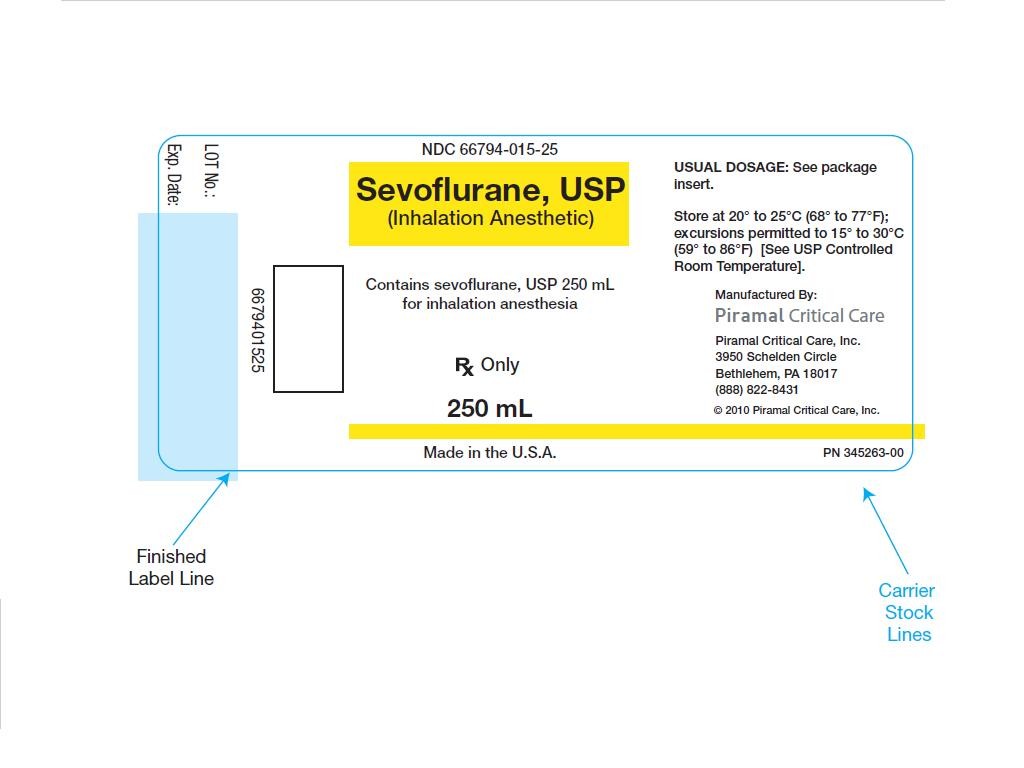
Bottle Label - 100 ml
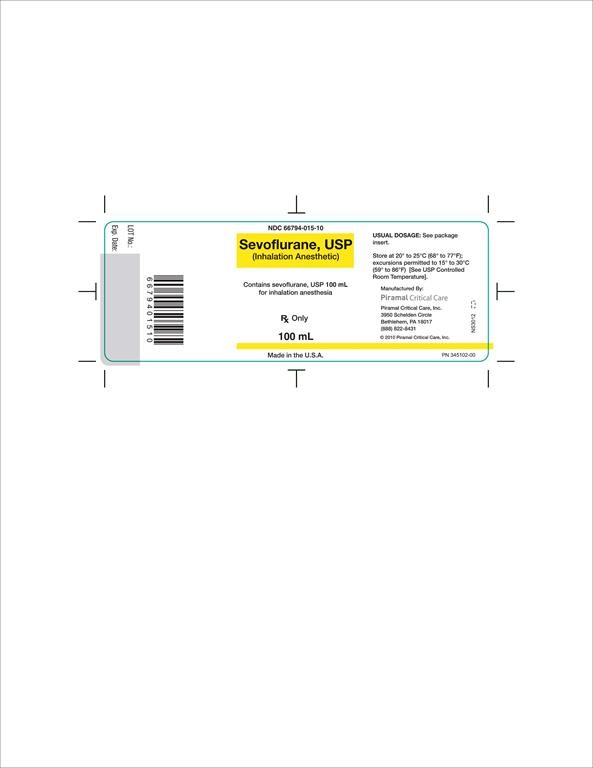
SevofluraneSevoflurane INHALANT
| ||||||||||||||||||||||||||||||||||||||||||||||||||||||